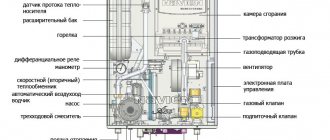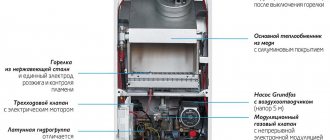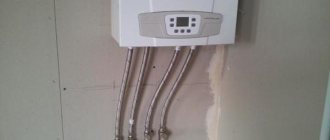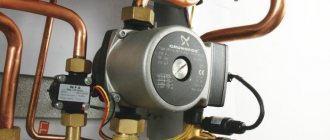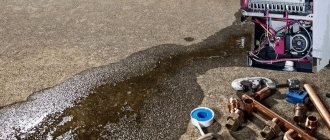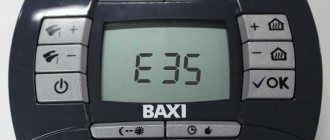Protherm gas boilers are high-quality, but relatively inexpensive heating installations for the mass consumer.
In this case, the pricing policy does not in any way reflect the capabilities or functionality of the equipment, since almost all the parts are used from the flagship of European heating engineering - Vaillant, a subsidiary of which is Protherm[/anchor].
Slovak boilers are intended for sale in Russia, so they immediately adapt to specific technological conditions - work in difficult climatic conditions (with increased loads), with changes in water or gas pressure, power supply.
In order to promptly notify the user of any deviations that have occurred, a self-diagnosis system has been developed.
Let's take a closer look at this issue.
Basic errors and malfunctions in Protherm gas boilers
All possible problems are constantly monitored by self-diagnosis system sensors. This is a group of thermistors and other elements that are triggered when the specified operating mode changes.
The signal from the sensor passes to the electronic control board, which immediately gives an alert on the display. An alphanumeric code appears, such as F 01 or F 28 .
Each combination indicates a particular error, i.e. failure or failure of the corresponding unit unit.
IMPORTANT!
A complete list of errors, quite long, is outlined in the instructions, which are recommended to be kept on hand to quickly identify the problem node.
The operation of a gas boiler is entirely based on the use of a burner. This is the main and most critical component of the device, since it is the burner that performs the main task and is the source of maximum danger.
This determines the degree of control over its operation by the boiler automation . In addition, the condition of the heating circuit (presence and pressure of water) and the smoke removal system are subject to increased attention.
The Protherm boiler self-monitoring system includes several dozen items in its list, most of which determine the condition of gas equipment and smoke exhaust systems as areas of increased danger. However, less important elements are not left unattended.
Decoding
The manufacturer points to a malfunction of the gas valve. The meaning of error f62: the Proterm boiler automation detects the burner flame after a command to block the fuel supply (closing the main valve).
Service technicians note that gas valves on Protherm often “stick,” although a malfunction of the unit is not the only factor that causes code 62 to appear. The difficulty of finding the cause is in the variety of types of Protherm boilers and problems that lead to the display of code 62. And electronics are unpredictable – different symbolism is initiated by identical factors, sometimes several of them at the same time. The article contains recommendations from professionals and users based on their experience in eliminating error f62. The reader will find a hint and solve the problem on his own.
What to do
Proterm power supply from a UPS ensures stable operation of the heating unit during network surges, low/high U values, changes in parameter f, or line failure. A traditional stabilizer is useless when the industrial voltage is turned off.
Installing a dielectric coupling on the gas main eliminates the influence of interference on the operation of the electronics of the Proterm boiler and reduces the likelihood of false fault codes appearing.
What to pay attention to
Ionization sensor
Controls the presence of a burner flame by sending a corresponding signal to the electronic board (position 8 in the figure). Often causes a false error in the Proterm boiler. With code f62, troubleshooting should begin with it - access is simple, and it does not require much time for diagnostics.
Causes
Burner
It would seem that this node has nothing to do with it. But some users and technicians note that after cleaning the nozzles, error f62 disappears from the Proterm boiler display.
Methodology
Use a toothbrush and vacuum cleaner. Pull-in only!
There are tips on the Internet for blowing out accumulated dust and soot, but you should not follow them - the result will be the opposite.
The smallest fractions will scatter to the sides, clog the burner nozzles of the Proterm boiler, and instead of eliminating error f62, the user will be faced with a host of other problems.
Gas valve block
In different types of Proterm boilers, the units differ in design. Self-disassembly is not recommended, but a number of defects can be identified and eliminated.
Causes
When dismantling, do not damage (lose) the gaskets. They can be reused. After putting the block in place, check the tightness by washing the places where the tubes are connected.
Flue gas sensor
It becomes the cause of error f62 for a number of Proterm boiler models. If the board receives a signal about a high temperature in the chimney after closing the gas valve, the electronics detects the continuation of the combustion process, which it informs about with code 62. The sensor malfunction is associated with a change in characteristics - the device is in the region of increased t 0, and its parameters “float” over time " Replacement eliminates error f62.
When installing a turbo nozzle on Proterm, the boiler sensor must be turned off. If this is not done, code f62 appears after starting the unit.
Electronic board
The “brain” of the Proterm boiler, which controls all processes. It is expensive (up to 13,900 rubles), and the EPU should not be changed without diagnostics. It is not advisable to interfere with the circuit on your own, or “tinker” based on advice from forums - depending on the year of manufacture of the unit, the series in the EPU there are differences.
What to do
Pay attention to dielectric capacitors. A swollen barrel indicates the cause of error f62.
Useful tips
Share your experience
If you have experience in correcting error F 62 in a Protherm gas boiler, write in the comments to this article, we will try to consider your option and analyze it in detail in this or one of the following articles. You can also send photos and videos with comments and descriptions.
Source
How to run self-diagnosis
The self-diagnosis system operates in constant mode. The start-up occurs simultaneously with the start of the boiler, and the system can only be stopped when the unit is stopped. Therefore, no special actions are required to enable self-diagnosis .
There is no need for special contact with the system; if a problem occurs, it will immediately report it, and if no notifications are received, it means that the boiler is operating normally and no problem points have been detected.
Important Rules and Precautions
It's no secret that using faulty gas equipment is life-threatening. At any moment, a trivial error that could be eliminated by a specialist in 15-20 minutes can become fatal and provoke an explosion.
Therefore, before you begin repair work, remember and never break the following rules:
- Not all errors can be eliminated on your own - some of them indicate system failures, the elimination of which requires only a specialist. Opening the boiler and carrying out repairs without permission to carry out these manipulations and without experience is fraught with negative consequences.
It is strictly forbidden to open the internal parts of the boiler - diagrams on the Internet, tips from mechanics or neighbors will not help if a person does not have the appropriate skill. This can damage expensive parts, the replacement of which will cost thousands of rubles.- You cannot use faulty gas equipment - some craftsmen bypass all the prohibitions by resetting the system, forcing the boilers to work bypassing the control of the central board. This leads to rapid wear of individual parts, as well as a high explosion and fire hazard.
- If all measures aimed at eliminating the error (the simplest ones) have not yielded results and the boiler still does not function, you should call the experts rather than carry out independent repairs.
A stingy person always pays twice, so trust the repair of your own equipment only to companies that specialize in such work. They will issue the appropriate document and also carry out repairs taking into account the characteristics of the breakdown. It's one thing to add water to the system, but another to replace the circuit board or internal pump.
In order for the boiler to break down less often (and this often happens in winter, during the period of active use), before the start of the heating season, a preventive start-up should be carried out by calling specialists.
They will evaluate the operation of gas equipment, carry out routine cleaning of the heating element from scale, and also give advice on how to properly use the boiler in the future. Prevention is always better than replacing broken expensive parts.
All main codes and their decoding
Let's look at the main error codes for Protherm boilers:
| Code | Decoding |
| F00 | Exhaust pressure loss |
| F01 | The flame on the burner went out |
| F02 | Heating temperature sensor failure |
| F03 | Boiler overheating |
| F04 | DHW sensor failure |
| F05 | Other problems |
| F06-07 | Traction sensor failure |
| F08 | Gas valve failure |
| F09 | Hood grounding break |
| F10 | Malfunction or short circuit of the forward temperature sensor |
| F11 | Malfunction or short circuit of the return temperature sensor |
| F12-13 | Malfunction or short circuit of the DHW boiler temperature sensor |
| F14 | Collector sensor short circuit |
| F15 | Smoke sensor short circuit |
| F16 | Short circuit of traction sensor |
| F18 | Boiler grounding short circuit |
| F19 | Exhaust sensor short circuit |
| F20 | Overheating, emergency shutdown |
| F21 | Boiler shutdown due to exceeding parameters |
| F22 | Low water level |
| F23 | Large temperature difference between forward and return OB lines |
| F24 | Rapid increase in temperature |
| F25 | Excess of supply water temperature |
| F27 | Parasitic flame (signal of a non-existent flame on the burner) |
| F28 | Burner ignition failed |
| F29 | Burner flame loss |
| F35 | Failure in the flue gas exhaust system |
| F37 | Fan speed exceeds rated value |
| F81 | Circulation pump malfunction |
A complete list of codes is available in the user manual. In practice, only a few errors occur (or none at all), but there can be many possible problems.
The most common malfunctions of Proterm boilers
The F0 combination often appears on the display when the coolant pressure decreases, which must be maintained within 0.7 Bar. When the equipment stops, the LED next to the lightning symbols on the indicator will blink. As soon as the user adds liquid to the system, the process will resume, but sometimes this will require rebooting the device.
Error f1 on a protherm boiler is also often encountered during operation; a similar excess occurs when the supply of blue fuel is stopped, the flame goes out and the combination appears on the display.
Possible reasons include incorrect operation of the thermostat, or the lower set power value does not correspond to the data selected by the owner.
Failures of the igniter are common, the distance between the electrodes changes, which leads to failures in the process and the output of the corresponding error in the boiler proterm slope. Among the vulnerable parts it is worth noting:
- Cables.
- Ionized electrode.
- Transformer for ignition.
- Automation.
- Gas supply valve.
Error F2 in the boiler indicates a malfunction of the heating water temperature sensor; such breakdowns often occur in protherm boilers.
This is due to an open circuit, the diode in the form of lightning begins to blink, and the unit stops functioning. To accurately determine the problem, it is worth checking all the cables going from the sensor to the control panel.
Elimination of defects in work
Usually, the appearance of an error does not mean that the boiler is broken. It is possible that the sensor may trigger falsely in response to a power surge or for other reasons.
Therefore, the first reaction to an error is to reset it and restart the boiler. If the error appears again and again, more effective measures must be taken.
Let's look at ways to eliminate the most common errors:
- F03 . Boiler overheating. The temperature of the heating agent rose to the maximum 95°. After the temperature drops, the boiler will start automatically. If the error persists, the thermal fuse must be reset.
- F04 . Failure of the DHW sensor. Check the contacts and clean them from oxides. As a last resort, replace the sensor.
- F10-11 . Failure of the supply or return temperature sensors causes the boiler to shut down due to the inability to control the degree of heating of the system. Check the condition of the sensors, clean the contacts, and if the problem recurs, replace the faulty element.
- F20 . Overheating of the boiler can happen for various reasons. Most often, the culprit is poor circulation due to a broken pump impeller. It is also often difficult to heat water due to layers on the walls of pipelines. The sensors do not confirm that the set temperature has been reached, and the heat exchanger outside is already too hot. The solution to the problem will be flushing the heat exchanger.
- F28 . Check the presence of gas in the line. Clean the ionization electrode using fine sandpaper. Check the condition of the boiler grounding circuit. If all these measures do not give a positive result, look for the reason in the boiler’s electronic board. Most often you have to change it.
- F62 . Gas valve malfunction. The device requires maintenance, cleaning and lubrication. There may also be problems with the electronic control board.
- F75 . Problems with the pressure sensor. Check the total pressure in the system. Inspect the condition of the pump. Bleed the air in the radiators using a Mayevsky tap.
It is inappropriate to provide a complete list of problems and ways to eliminate them, since the very name of the error most often contains a hint on how to fix it. The predominant type of solution to the problem is to replace the unreliable element.
F.10 — Short circuit of the NTC sensor at the OB output
- — a malfunction is indicated in the event of a short circuit of the NTC sensor installed at the OB output
- — the message will be automatically deleted after reconnecting the NTC sensor
- — a short circuit of the NTC sensor is detected if the voltage in its circuit is below 0.45 V
- The sensor in this case shows a deliberately incorrect value compared to that indicated in the table
RECOMMENDATIONS
- Check sensor connections
- Check sensor cables
- Check sensor resistance (replace if necessary)
How to turn it on
The boiler is started by pressing the round “main switch” button to the right of the display.
Power supply to all boiler systems begins. Usually the boiler is in standby mode, i.e. There is no preparation of coolant and hot water. The display shows the current state of the device, so the user can immediately determine what the boiler automation is currently doing.
To start the process, you need to set the temperature of the heating agent or hot water supply, after which the burner will start and the coolant will begin heating.
These actions will be accompanied by characteristic sounds of pump operation, water movement, and burner startup.
The boiler is stopped by simply pressing the main switch.
F.13 - Short circuit of NTC sensor of external DHW storage tank
— the fault is initiated on the boiler display in the event of a short circuit in the NTC sensor of the external DHW storage tank
— the message will be automatically deleted after reconnecting the NTC sensor
— a short circuit of the NTC sensor is detected if the voltage in its circuit is below 0.45 V
RECOMMENDATIONS
- Check sensor connections
- Check sensor cables
- Check sensor resistance (replace if necessary)
Doesn't start
There may be several reasons why the boiler does not light. The simplest one is that the power cable is not connected correctly.
Protherm boilers are phase-dependent, i.e. the phase must be connected to a specific electrode.
The same requirements apply to the “zero” and “ground” electrodes. The problem can be solved simply - you need to turn the plug over in the socket, or swap the electrodes if the design of the plug does not allow you to change its position.
Other reasons for the inability to start the boiler may be:
- No voltage in the network.
- No or extremely low gas pressure.
- Failure or breakdown of automation (control board),
- Short circuit of one of the sensors that can block the device.
All these reasons can block the launch and hold the problem until it is fixed. The search must be carried out in stages, from the simplest to the more complex reasons.
NOTE!
It is not recommended to independently interfere with the state of the boiler’s electronics or automation, especially if it is under warranty. All issues should be resolved only with the participation of technicians from the service center.
How to avoid errors: general tips and tricks
Prevention is always easier than dealing with the consequences. Remember these nuances:
- Work with gas equipment should only be trusted to professionals who provide a guarantee.
- Replacement of faulty parts should be made only with originals. If spare parts from other boilers are installed (used ones are especially dangerous), no one will be able to guarantee the safe operation of such equipment.
- Perform preventative cleaning of the boiler annually. There are special companies that provide these services in full.
- Don't forget to check your hood. Sometimes it can become clogged.
- Do not allow the temperature in the room where the boiler is located to fall below 3°C.
- Check the water level in the system, paying attention to the pressure. The standards for your boiler are written in the operating manual.
Expert opinion
Filimonov Sergey Vinokurovich
Heating equipment repairman
The most important rule is to never use a boiler if it is faulty and constantly displays certain errors.
In conclusion, it is worth noting that Proterm gas boilers in rare cases issue fault codes incorrectly. If this happens, then it is necessary to determine the cause and eliminate it. Only a specialist can carry out a complete diagnosis, as well as repairs. It is not recommended to open the cover and replace parts yourself, as this may be unsafe for health and life in general.
Why does the pressure in the device increase?
A rise in pressure is an extremely dangerous situation, fraught with mechanical failure and even an explosion.
The liquid is incompressible; it fills the entire volume of the pipelines. If the pressure on the pressure gauge approaches 3 mbar and continues to rise, it’s time to take action.
One of the reasons is the failure of the expansion tank. When heated, the liquid expands and its volume increases by 4% .
A normally functioning expansion tank absorbs this excess interest, but if it is already full, the excess liquid simply has nowhere to go. This situation can be determined by the state of the relief valve - heating agents will constantly ooze out of it.
The main failure of the expansion tank is membrane rupture . With it, water fills the tank completely, leaving no room to accommodate the expanded liquid. The solution would be to replace the membrane or the entire expansion tank.
Another possible reason is that the supply valve is not closed or has failed. Water continues to flow into the system, increasing the pressure.
It is necessary to check the condition of the tap and turn it off or replace it. You should check the condition of all shut-off valves and clean the strainer. There may also be problems with the boiler automation, which can only be resolved with the help of a specialist from the service center.
Why does blood pressure drop?
A drop in pressure indicates a leak. It can be not only in the boiler, but also anywhere in the system - radiators, pipelines, taps, etc. Often the cause is a failed relief valve, which gradually releases water from the system into the sewer system.
The way to solve the problem is to search, detect the problematic element causing the leak, and repair or replace it.
How to connect to electricity
The electronics of gas boilers are demanding on the correct connection of the phase, zero and ground electrode.
If the contacts are reversed when connecting, the boiler will not start. Therefore, it is important to use a special plug and socket that does not allow you to connect the device in any other way. When running the cable, you need to check the correct distribution of the electrodes in the socket.
To check, use a probe screwdriver or other special devices.
Connecting a room thermostat
A room thermostat allows you to more accurately adjust the indoor microclimate . Its sensor checks the air temperature, which gives more accurate results than checking the extract air temperature, which is produced by the boiler electronics.
Using a room thermostat allows you to turn off the boiler when the set values are reached, when the device’s own sensors are not yet ready to give a command to stop heating.
The thermostat is connected to a special gap in the control board, the contacts of which are closed by default with a jumper.
To connect, turn off the boiler, open the lid and remove the jumper . Then the room thermostat is connected in the required order and a test switch is performed.
If the device operates normally, close the lid and proceed to further operation of the boiler with additional equipment. If problems are found, they are corrected immediately.
IMPORTANT!
Detailed instructions for connecting a room thermostat are available both on the device itself and in the user manual for the boiler. Under no circumstances should you act at random.
F.19 - Short circuit of outside temperature sensor
— a malfunction is indicated in the event of a short circuit of the outside temperature sensor
— the message will be automatically deleted after reconnecting the NTC sensor
— a short circuit of the NTC sensor is detected if the voltage in its circuit drops below 0.45 V
— the error is not indicated if the equithermal control function is inactive (E-)
— in this case, the boiler continues to operate in normal heating mode (without equithermal regulation)
RECOMMENDATIONS
- Check sensor connections
- Check sensor cables
- Check circuit voltage
- Check sensor resistance (replace if necessary)
